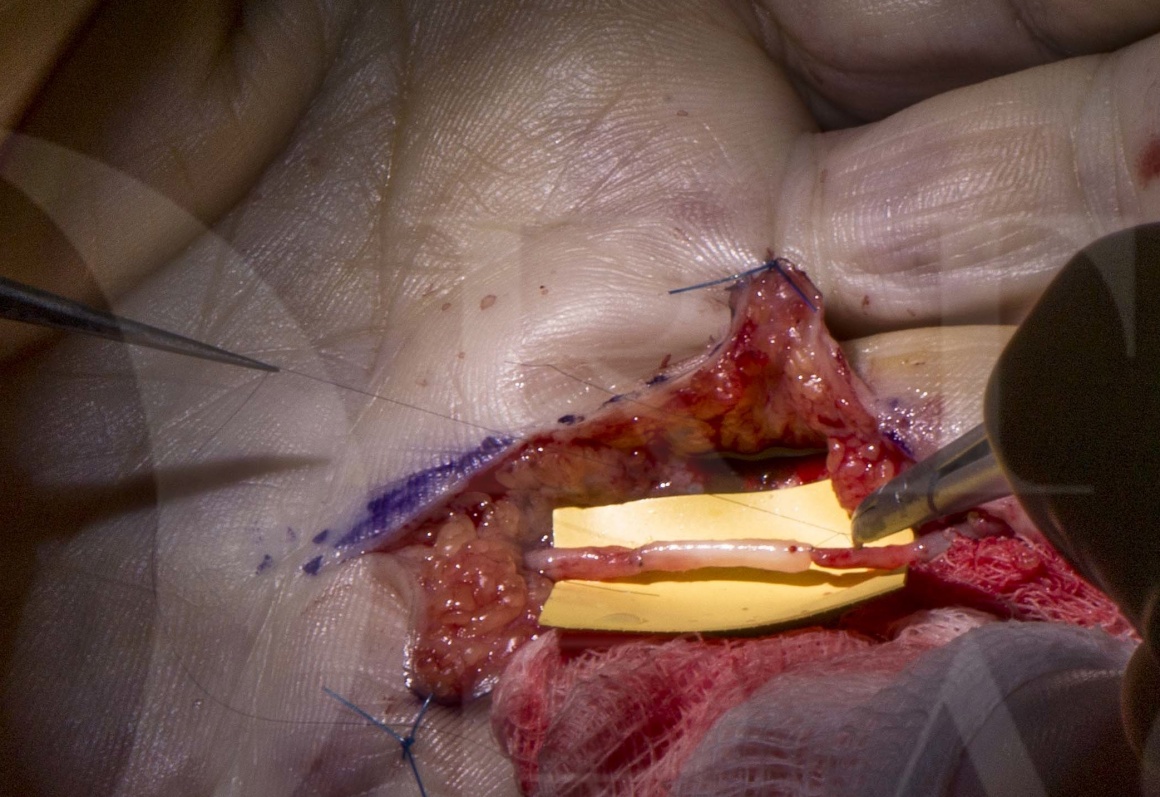Digital nerve repair: Reconstruction with Axogen Avance processed nerve allograft
Overview

Subscribe to get full access to this operation and the extensive Upper Limb & Hand Surgery Atlas.
Learn the Digital nerve repair: Reconstruction with Axogen Avance processed nerve allograft surgical technique with step by step instructions on OrthOracle. Our e-learning platform contains high resolution images and a certified CME of the Digital nerve repair: Reconstruction with Axogen Avance processed nerve allograft surgical procedure.
This case demonstrates the technique of bridging a small nerve gap with a processed nerve allograft.
Digital nerve injuries are a common consequence of penetrating hand injuries and are typically managed by direct microsurgical repair following exploration and wound debridement. The absence of tension across a direct epineurial nerve repair is an important factor in the success of digital nerve repair.
In many cases this is difficult to achieve due to segmental loss, scarring and retraction in missed injuries, or following the required debridement of crushed or contaminated nerve ends.
In such scenarios autologous nerve graft may be used to bridge a defect and provide an environment for nerve regeneration across a gap. The disadvantages of autograft include increased operative time and cost as well as donor site morbidity which include painful neuroma formation and sensory loss. This technique is covered elsewhere on the OrthOracle platform Nerve grafting for digital nerve defect (autograft using medial cutaneous nerve of forearm)
The search for alternative strategies to avoid autograft is ongoing. Several studies have reported upon the success of artificial nerve conduits for bridging short gaps and one such technique is covered elsewhere on the OrthOracle platform Digital nerve conduit-assisted repair with the NeurolacTM (Polyganics)
The use of nerve allograft to bridge gaps has demonstrated reasonable efficacy. Unprocessed nerve allografts will contain cellular material and immunosuppression is required until the nerve has regenerated and antigenic and cellular material has been replaced by the host. This is a major drawback and poses a significant risk of infection and other side effects from immunosuppressant therapy in otherwise healthy individuals.
Development of processed nerve allograft has removed the need for immunosuppression. AxoGen Inc is a biomedical device company that has proprietary technology for the removal of cellular debris and neuroinhibitory glycosaminoglycans (GAGs) including chondroitin from the donor nerve material. A series of enzyme washes and subequent sterilisation with gamma irradiation preserve the mechanical integrity of the endoneural tube structure of peripheral nerves. Sections of varying diameters (1-2mm/2-3mm/3-4mm/4-5mm) and lengths (15mm/30mm/50mm/70mm) are provided frozen and can be rapidly defrosted in warm saline prior to use.
The AVANCE TM processed nerve allograft (Axogen Inc. Alachua, Florida, USA) has demonstrable efficacy in short sensory nerve gaps that is comparable to autologous nerve grafts. the evidence for longer gaps and for mixed motor-sensory nerve reconstruction is more limited. A post-marketing surveillance registry study (RANGER) continues to collect results of allograft use internationally ad publishes regular reports on efficacy in the medical literature.
In the UK, the National Institute for health and care Excellence (NICE) have outlined (in IPG597) that there is enough evidence to support the use of processed nerve allograft in digital nerve gaps provided that standard arrangements are in place for clinical governance, consent and audit.
However, due to limited evidence for indications other than digital nerve repair, NICE recommend that for these cases, processed nerve allograft only be used with special arrangements for clinical governance, consent and audit or research.
Author: Tahseen Chaudhry, Consultant in peripheral nerve surgery
Institution: Queen Elizabeth Hospital, Birmingham, UK
Clinicians should seek clarification on whether any implant demonstrated is licensed for use in their own country.
In the USA contact: fda.gov
In the UK contact: gov.uk
In the EU contact: ema.europa.eu
Online learning is only available to subscribers.



















